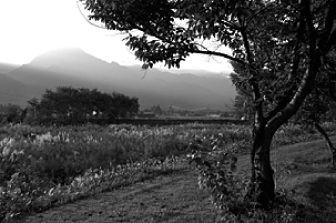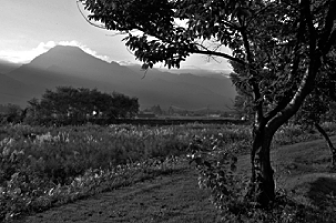Preserving Detail in Highlights and Shadows (Active D-Lighting and HDR)
Active D-Lighting
Active D-Lighting, accessed via the [] item in the photo or movie shooting menu, is used to preserve details in highlights and shadows, creating pictures with natural contrast. Use for high-contrast scenes, for example when photographing brightly-lit outdoor scenery through a door or window or taking pictures of shaded subjects on a sunny day. Active D-Lighting is most effective when [] is selected for metering.
|
[] |
[] |
Active D-Lighting Options
|
Option |
Description |
|
|---|---|---|
|
Y |
[] |
The camera automatically adjusts Active D‑Lighting in response to shooting conditions. |
|
3 |
[] |
Choose the amount of Active D-Lighting performed from [], [], [], [], and []. |
|
Z |
[] |
|
|
P |
[] |
|
|
Q |
[] |
|
|
R |
[] |
|
|
[] |
Active D-Lighting off. |
|
-
“Noise” in the form of randomly-spaced bright pixels, fog, or lines may appear in photos taken with Active D-Lighting.
-
In mode M, [] is equivalent to [].
-
Uneven shading may be visible with some subjects.
-
Active D-Lighting does not apply at high ISO sensitivities (Hi 0.3–Hi 5), including high sensitivities selected via auto ISO sensitivity control.
-
The [] option in the movie shooting menu offers a choice of [], [], [], [], and [].
High Dynamic Range (HDR)
The [] item in the photo shooting menu can be used with high-contrast subjects to preserve details in highlights and shadows by combining two shots taken at different exposures. Use with high-contrast scenes and other subjects to preserve a wide range of details, from highlights to shadows.

HDR Options
|
Option |
Description |
|---|---|
|
[] |
|
|
[] |
Choose the difference in exposure between the two shots. The higher the value, the greater the dynamic range. If [] is selected, the camera will automatically adjust the exposure differential to suit the scene. |
|
[] |
Choose how much the boundaries between the two images are smoothed. |
|
[] |
Choose [] to save each of the individual shots used to create the HDR image; the shots are saved in NEF (RAW) format. The shots are saved at an image size of [], regardless of the option selected for [] > [] in the photo shooting menu. |
Taking HDR Photographs
We recommend that you use the [] metering option when shooting with HDR.
-
Highlight [] in the photo shooting menu and press 2.
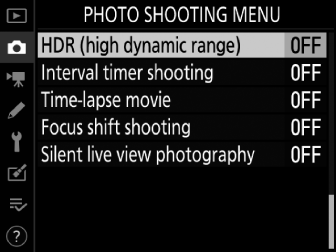
-
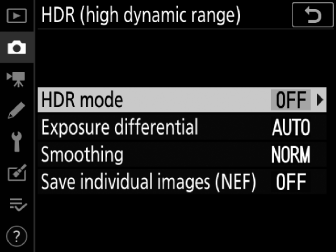
-
Highlight [] and press 2.
-
Highlight one of the following options using 1 or 3 and press J.
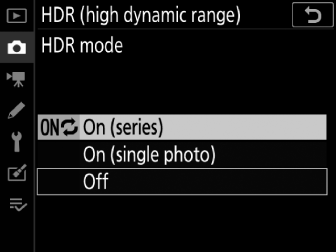
Option
Description
[]
Take a series of HDR photographs. HDR shooting will continue until you select [] for [].
[]
Normal shooting will resume after you have taken a single HDR photograph.
[]
Proceed without taking additional HDR photographs.
-
If [] or [] is selected, an y icon will be displayed in the top control panel while HDR mode is in effect.
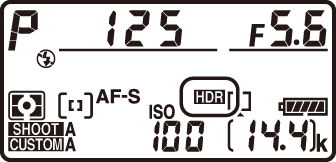
-
-
Choose a value for [].
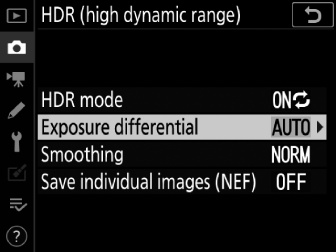
-
Highlight [] and press 2.
-
Highlight an option using 1 or 3 and press J.
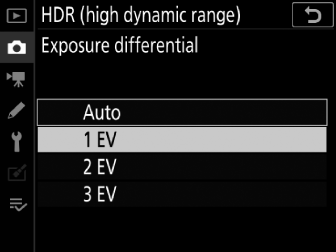
-
Choose higher values for high-contrast subjects.
-
Note, however, that choosing a higher value than required may not produce the desired results. Match your choice to the level of contrast in the scene.
-
If [] is selected, the camera will automatically adjust the exposure differential to suit the scene.
-
-
Adjust [].
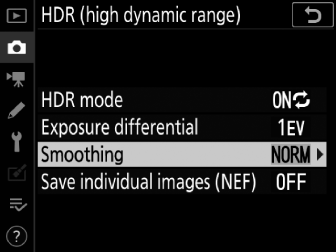
-
Highlight [] and press 2.
-
Highlight an option using 1 or 3 and press J; the selected option represents the amount the boundaries between the two images are smoothed.
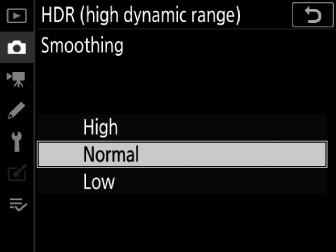
-
Higher values produce a smoother composite image.
-
-
Choose a setting for [].
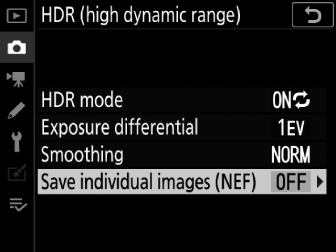
-
Highlight [] and press 2.
-
Highlight an option using 1 or 3 and press J.
-
Choose [] to save each of the individual shots used to create the HDR image; the shots are saved in NEF (RAW) format. The shots are saved at an image size of [], regardless of the option selected for [] > [] in the photo shooting menu.
-
-
Frame the photograph, focus, and shoot.
-
The camera takes two exposures when the shutter-release button is pressed all the way down.
-
Flashing “1” and “k” indicators appear respectively in the top control panel and viewfinder while the images are combined. No additional pictures can be taken until recording is complete.
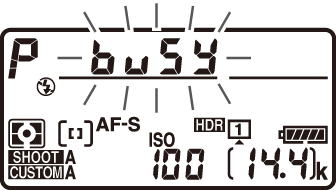

-
If [] is selected for [], you can continue to take HDR photographs until [] is selected.
-
If [] is selected, HDR will turn off automatically after a single shot.
-
HDR photographs taken when an NEF (RAW) or NEF (RAW) + JPEG option is selected for image quality will be recorded in JPEG format.
-
The edges of the image will be cropped out.
-
The desired results may not be achieved if the camera or subject moves during shooting. Use of a tripod is recommended.
-
Depending on the scene, you may notice shadows around bright objects or halos around dark objects. This can be mitigated using [].
-
Uneven shading may be visible with some subjects.
-
With non-CPU lenses and when [] or [] is selected, an [] of [] is equivalent to [].
-
Optional flash units will not fire.
-
In
ClandChmodes and during burst photography in mode Q, only one photograph will be taken each time the shutter-release button is pressed all the way down. -
Shutter speeds of A (“Bulb”) and % (“Time”) are not available.
HDR cannot be combined with some camera features, including:
-
Bracketing
-
Multiple exposure
-
Interval-timer photography
-
Time-lapse movies
-
Focus shift
When [] is selected for Custom Setting f3 [] > [], [] (Step 2) and [] (Step 3) can be selected using the BKT button and command dials.
-
Hold the BKT button and rotate the main command dial to choose from the following HDR modes: a ([]), 1 ([]), and b ([]).
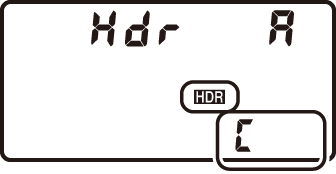
-
You can choose the exposure differential by holding the BKT button and rotating the sub-command dial.


